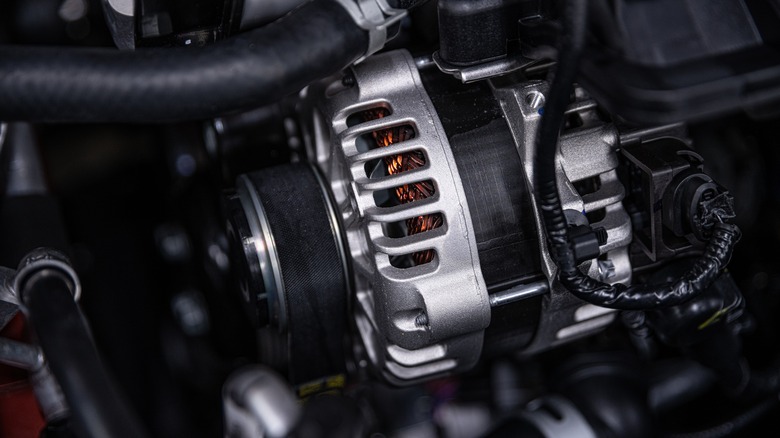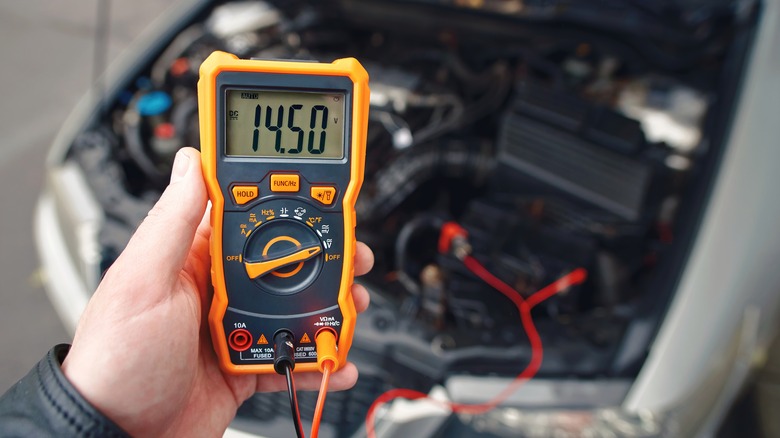
Daniel Jedzura/Shutterstock
The battery is often the first thing that comes to mind when people think about what powers a car’s electrical system. After all, batteries are what supply power to most of our devices. However, things work a little differently in cars, where the battery’s primary job is to start the engine. Once the engine is up and running, the alternator takes over, powering your car’s electrical system and recharging the battery while the engine is running. From headlights to windshield wipers, the alternator powers everything electrical in your vehicle.
So, as you can imagine, when it’s not working, you’re going to have problems. When an alternator malfunctions, it disrupts your car’s entire electrical system — inevitably causing the battery to die, which can leave you broken down. That’s why being familiar with the tell-tale signs your alternator is failing is so important. Recognizing these signs can save you time and money, allowing you to make timely repairs and ensuring your car’s reliability and safety while on the road.
Electrical issues and warning lights

Andriano_cz/Getty Images
Since the alternator controls your car’s electrical system, one of the first things you’ll notice when things go wrong is that your vehicle’s electronic components start behaving erratically. Pay attention if your headlights start to dim or flicker because this could be a sign your alternator isn’t generating enough power to keep them at their full brightness. While it may seem counterintuitive, the reverse can also happen, with headlights shining too brightly. You may also notice them alternating between the two, going back and forth from dim to bright. Also, keep an eye out for things like interior lights, the dashboard display, and the radio showing signs of insufficient power, like dimming, flickering, or completely shutting down.
Another sign your alternator may be in trouble is when the battery on your car’s dashboard comes on. Although you may think your battery is having problems when you see this light, it’s often an indicator that something is wrong with the car’s electrical system and it’s not getting enough power from the alternator. It’s important to know the difference between a bad battery and a failing alternator. If your car starts up without any issues and you mainly experience electrical issues while it’s running, you’re probably dealing with an alternator problem.
Unusual noises and physical inspection

Morsa Images/Getty Images
Your ears can be an ally in detecting problems with your alternator. As any driver knows, cars make all sorts of sounds, making this sign more difficult to recognize. However, if you pay close attention to new or unusual sounds, they’ll often tip you off when something isn’t quite right. A whining sound from your car could be a sign of a straining alternator, while a grinding noise may indicate internal bearing failure. You may hear rattling noises if your alternator’s mounting has become loose or there are issues with the drive belt.
Physically inspecting your alternator is the next step in identifying a problem if you’ve heard any of these odd noises. You can do a visual check for looseness in the drive belt, signs of cracking, or excessive wear. Also, look for any signs of visible damage to the alternator, such as corrosion or leaks. If you still have questions, taking your car in for a professional inspection is best. A mechanic can thoroughly examine and run tests to check your alternator’s health.
Voltage and battery tests

Tricky_Shark/Shutterstock
If you’re comfortable getting under the hood of your car and performing basic checks, using a multimeter to conduct a battery and voltage test is a straightforward way to diagnose alternator issues.
Follow these steps to perform a battery and voltage test:
- Set your multimeter to the 20 DC voltage setting.
- With the engine off, connect the multimeter’s red probe to the battery’s positive terminal and the black probe to the negative terminal. A healthy battery should show around 12.6 volts.
- Start the engine and take the same voltage reading. The voltage should now be between 14 and 14.5 volts, indicating the alternator is charging the battery. If the reading drops below 14, it could mean that the battery is bad or there is an alternator issue.
- Turn off the engine and all accessories. A reading below 12.2 volts suggests the battery is not fully charged or failing.
- Turn on all of the vehicle’s electronics, including the headlights, interior lights, climate control system, and radio, to use the place of the car at its maximum voltage load. Keep an eye on the multimeter: if the reading falls under 13.5 volts, your alternator is having trouble charging the battery properly and may need to be replaced.
These tests will help you confirm whether you’re dealing with an alternator issue or just a battery that needs charging. Testing your vehicle regularly can help prevent breakdowns and keep your car’s electrical system running smoothly.